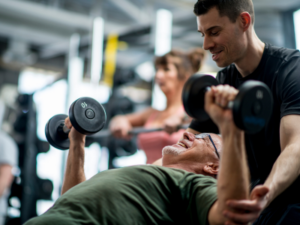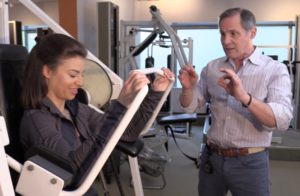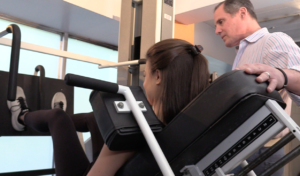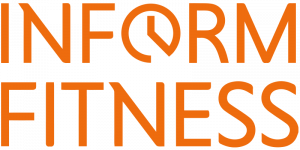![]()
A recent New York Times article about the Functional Fitness Movement, “Fitness Playgrounds Grow as Machines Go“ by Courtney Rubin, has me fuming. My core mission has long been to promote safe, efficient exercise, and this new fad is neither efficient nor safe.
The premise of their version of ‘Functional Fitness’ is that we need to train and strengthen our bodies in ways that mimic the activities of our hunting and gathering predecessors in order to prepare us for the physical challenges of daily life. As the article’s title suggests, functional training is offered at jungle-gym-type, adult playgrounds, which are noticeably absent of expensive exercise machines.
Though the concept may seem plausible, the article is riddled with infelicitous comments such as machines are inadequate for preparing people for everyday life.
Dating back to Ancient Roman times, true functional training had been, and continues to be, an important prescription in physical and occupational therapy. As an example, if someone sustains an injury, then functional training would help the patient to regain full range of motion and use of their injured body part. The original meaning of functional training has been hi-jacked by the fitness industry and crafted into a dangerous fad.
I credit the New York Times for having the good sense to have placed this article in the Fashion and Style section and not Science. Perhaps the most appropriate placement would have been in the Business section since the real story here is how gyms are changing to make a bigger profit, as evidenced by the following excerpt:
“The functional fitness zones also are a moneymaker for gyms, costing $5 to $6 a square foot, compared with some $50 a square foot when filled by machines, estimated Bruce Mack, the founder and chief executive of the Boston-based MBSC Thrive.”
Though I recognize business decisions designed to improve profitability, ethics should dictate that these profit motivated decisions not raise the risk of injury.
In the article, Adam Campbell, fitness director for the Men’s Health brand, comments “Functional fitness is far more bang for your buck, because it works multiple muscles simultaneously, providing better overall strength and mobility, and a higher calorie burn.” The article goes on to suggest that exercise machines resemble some form of ancient torture and suggests that balancing on a medicine ball, while swinging heavy bags or climbing a wall more closely represents our daily lifestyles, and as such, is really the kind of exercise needed. Maybe more people are preparing for a life as circus performers than I thought. Who knew?
My greatest concern is the blatant compromise of safety! Their form of ‘Functional’ training has the potential to cause both short and long-term injuries. A pulled muscle or pinched nerve is an immediate risk, but the unnecessary wear and tear on joints can cause problems that will haunt you in later years. The article suggests that machines are not natural. I wonder how many of us include “hefting sandbags and shaking 25-pound ropes” as a natural part of our daily routine.
The stated goal of ‘Functional Training’ is to improve strength. Since strength comes from muscles, to improve strength you should build muscle. I do not mean bulking up into The Hulk. Done properly, weight-bearing workouts can achieve the “lean, athletic as opposed to highly muscular,” personal appearance that Mr. Campbell speaks about. You can bulk up if your gene pool permits, but bulk is otherwise not a natural outcome of machine based exercises. Perpetuating that fear is just a marketing gimmick.
People do need to learn how to lift weight safely. One day you might have the privilege of picking up a child on a regular basis, and learning to lift properly will help you avoid injuring your back. You also need strength to perform the task, but equally important is the proper lifting technique. Learning how to bend, twist, and lift safely is a different course from a program to build strength, and does not require on-going training. Once proper technique has been learned, building strength is a separate activity, and should be designed and performed to avoid putting your joints or spine at risk. If you want to get stronger, you must load the right muscles with the right amount of resistance to engage enough muscle fibers.
The risk of injury is more likely to occur in these new functional gym environments. Distractions are significant obstacles to ensuring safety. Checking out the guy on the rock-climbing wall, the noise, your exhausted state, or worrying about how you look, all while standing on an uneven surface lifting a heavy weight and turning your body can result in serious injury. You are almost guaranteed to be leaving the gym with a complimentary ice pack to ease the pain of a torn or strained muscle, or a pinched nerve.
The exercises promoted in these new ‘Functional Training’ gyms put your spine at substantial risk as you lift and shift weights simultaneously while the body is in exaggerated motion.
“The bones and muscles of the spine are not suited for top-heavy loads.”1 If you look at any picture of the spine, you will notice that the bones get smaller the higher up they go. Every manual laborer knows to lift with their legs not their back, and to keep the spine steady and protected.
“The system below the pelvis provides for speed and power: big superficial muscles pull on few, solid beams of bone, moving through large ranges of motion, in few directions. Above the pelvis, there’s no muscle match for the gluteus (buttocks) or quads (thighs); and even if there were, the spine isn’t a beam like the femur. With the spine, many muscles only have to hold or move slightly, the next vertebrae. This system provides mobility, with stability, for the overall spine.” 1
Since we rely on our spine for range of motion, these bones are not connected in the same way as our joints. Equally as noticeable is that we require more range of motion where the bones are smaller, such as the neck supporting your head. Your spine is structured to support more weight at the base then at the top, and exercising against the natural order is a recipe for injury.
Slow-motion weight training, such as the Power-of-10 protocol, performed on weight machines, is designed to keep the spine from experiencing misplaced weight loads and torque that could result in injury.
These new gyms and their ‘Functional Training’ are dangerously off base in their attempt to simultaneously engage both the primary mover muscles that move limbs with the deep muscles that stabilize joints. Even worse is engaging the primary muscles on surfaces that are unstable. This is how most common injuries occur. And the injuries usually affect the deeper, stabilizer muscles. Back spasms are more likely than a glute strain; or rotator cuff injury rather than deltoid; or groin pulls rather than the quadriceps; and therefore jeopardizing long-term joint health. Ouch!
Please, for your safety, keep your movement exercises separate from your strength training exercises. If you want to exercise for movement try Tai Chi. To build strength, employ safe, efficient exercise that stabilizes the spine and is designed to protect the deep muscles.
*******************
1. Bill Desimone, Congruent Exercise: How to Make Weight Training Easier on Your Joints









